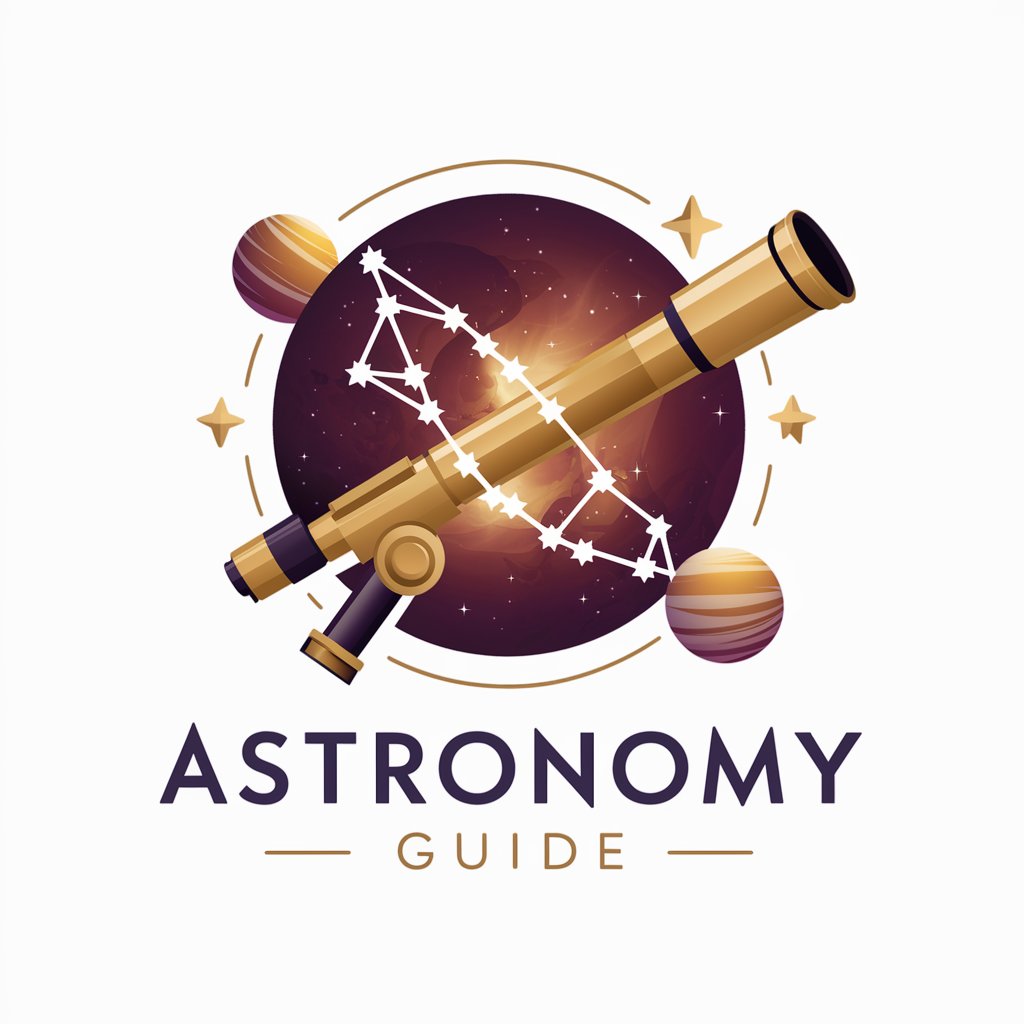Astronomy - Interactive Astronomy Learning

Hello! Ready to explore the cosmos together?
Explore the cosmos with AI-powered guidance
Can you explain the different types of telescopes and their uses?
What are some tips for beginner astrophotographers?
How can I identify constellations in the night sky?
What are the most notable astronomical events this year?
Get Embed Code
Introduction to Astronomy Guide
Astronomy Guide is designed as a comprehensive assistant for anyone curious about the cosmos, from beginners to seasoned astronomers. Its purpose is to demystify the vast universe, making the study of celestial bodies, constellations, and astronomical phenomena accessible and engaging. Through detailed explanations, practical advice, and references to significant astronomical events, it seeks to foster a deeper appreciation and understanding of the universe. For instance, it can guide a novice in identifying constellations in the night sky, offer insights into the latest astronomical research, or provide tips on capturing the beauty of the cosmos through astrophotography. Powered by ChatGPT-4o。

Main Functions of Astronomy Guide
Educational Resources
Example
Explaining the life cycle of stars from formation to supernova
Scenario
A high school student uses the guide to prepare a project on stellar evolution, finding detailed yet accessible information that enriches their presentation.
Stargazing Assistance
Example
Identifying planets and constellations in the night sky
Scenario
An amateur astronomer relies on the guide for tips on the best times and locations for stargazing, enhancing their experience and understanding of visible celestial phenomena.
Telescope and Equipment Advice
Example
Choosing the right telescope for beginners
Scenario
A budding stargazer consults the guide to navigate the complex market of telescopes and accessories, finding recommendations that fit their needs and budget.
Astrophotography Tips
Example
Capturing the Milky Way with a DSLR camera
Scenario
An enthusiast learns through the guide how to set up their camera for night sky photography, achieving stunning images of the Milky Way.
Astronomical Event Alerts
Example
Information on upcoming eclipses, meteor showers, and planetary alignments
Scenario
A family plans an evening of meteor shower viewing using the guide's detailed schedules and viewing tips, making for a memorable experience.
Ideal Users of Astronomy Services
Amateur Astronomers
Individuals with a budding interest in astronomy who seek to deepen their knowledge and practical skills in observing the night sky, identifying celestial objects, and understanding cosmic phenomena.
Students and Educators
Students of all ages looking to supplement their education with rich, detailed information on astronomical topics, as well as educators seeking resources to enhance their teaching and engage their students.
Astrophotographers
Photography enthusiasts interested in capturing the beauty of the cosmos, from planets and stars to galaxies, using the guide's tips for equipment, settings, and techniques.
Science Communicators and Writers
Professionals who communicate complex astronomical concepts to the public, utilizing the guide to ensure accuracy and clarity in their content.
Space Enthusiasts
Individuals fascinated by space exploration and celestial events, who use the guide to stay informed about the latest discoveries, missions, and observational opportunities.

How to Use Astronomy Guide
Start with a Free Trial
Begin by accessing a free trial at yeschat.ai, offering immediate usage without the need for a login or a ChatGPT Plus subscription.
Identify Your Interests
Decide what aspects of astronomy you're most interested in, whether it's learning about constellations, celestial events, or using telescopes.
Engage with Interactive Features
Use the tool's interactive features to explore the cosmos, including star maps, celestial event calendars, and telescope advice.
Participate in Community Discussions
Join forums or community discussions to share your observations, ask questions, and learn from experienced astronomers.
Experiment and Observe
Apply what you've learned by observing the night sky, experimenting with astrophotography, or attending star-gazing events.
Try other advanced and practical GPTs
Spabot
Empowering Pregnancy Wellness with AI

Opinion Scholar
Insightful AI-powered Opinion Analysis

Idea Innovator
Empowering Innovation with AI

Frosty's HVAC Customer Assistant
AI-powered HVAC Expertise at Your Fingertips

SEO Weboost
Boost Your Shopify SEO with AI

GGad Advisor
Elevate Your Ads with AI-Powered Insights

Music Career Mentor
Empowering Your Music Career with AI

CSA: Content Assistant
Elevate Your Content with AI

Cooach Assistant
Empowering businesses with AI-driven insights

Metal Mentor
AI-powered welding and fabrication mentor

DSGVO Guide
Navigate GDPR with AI-powered guidance

AI Enthusiast
Unlock AI insights and guidance

Astronomy Guide Q&A
What is the best time of year to observe the Milky Way?
The best time to observe the Milky Way is during summer months in the Northern Hemisphere, when it's visible from dusk until dawn, offering a spectacular view of its dense, star-filled core.
How can beginners start with astrophotography?
Beginners can start with astrophotography by using a DSLR camera mounted on a tripod to capture long exposure shots of the night sky, starting with bright objects like the Moon or planets.
What are some must-see celestial events?
Must-see celestial events include solar and lunar eclipses, meteor showers like the Perseids and Geminids, and planetary alignments, all offering unique and breathtaking skywatching experiences.
How do I choose a telescope?
Choosing a telescope depends on your interests and budget. For beginners, a refractor or a small reflector telescope is recommended, focusing on ease of use and maintenance.
Can I identify constellations without a telescope?
Yes, many constellations can be identified with the naked eye by learning their star patterns and using a star map or mobile app to help guide your observations.
